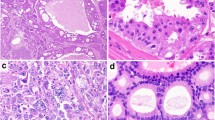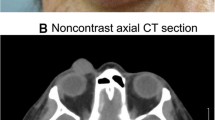Abstract
Purpose
To evaluate metabolic alterations along with the carcinoma ex pleomorphic adneoma (CXPA) development of lacrimal glands (LG).
Methods
Four samples of the normal LG (NLG), 9 of pleomorphic adenoma (PA), 4 of residual PA (rPA), and 4 of CXPA of LG were included. GLUT-1, HIF-1α, FASN, and adipophilin by immunohistochemical stains were performed in the selected cases.
Results
Was observed higher expression of markers associated with glycolytic and lipid metabolism in the tumor tissue samples when compared to the NLG samples. Additionally, GLUT-1, FASN, and Adipophilin were more expressed in CXPA samples while HIF-1α in PA samples.
Conclusions
In conclusion, our results demonstrate overexpression of FASN and Adipophilin in CXPA which may reflect a metabolic shift toward lipogenesis in cancer cells.




Similar content being viewed by others
References
Andreasen S, Esmaeli B, von Holstein SL et al (2017) An update on tumors of the lacrimal gland. Asia Pacific J Ophthalmol 6:159–172. https://doi.org/10.22608/APO.201707
Grossniklaus H, Eberhart C, Kivela T (2018) WHO classification of tumours of the eye, 4th ed. IARC, Lyon, France
Le Tourneau C, Razak ARA, Levy C et al (2011) Role of chemotherapy and molecularly targeted agents in the treatment of adenoid cystic carcinoma of the lacrimal gland. Br J Ophthalmol 95:1483–1489. https://doi.org/10.1136/bjo.2010.192351
von Holstein SL, Coupland SE, Briscoe D et al (2013) Epithelial tumours of the lacrimal gland: a clinical, histopathological, surgical and oncological survey. Acta Ophthalmol 91:195–206. https://doi.org/10.1111/j.1755-3768.2012.02402.x
von Holstein SL, Fehr A, Persson M et al (2014) Lacrimal gland pleomorphic adenoma and carcinoma ex pleomorphic adenoma. Ophthalmology 121:1125–1133. https://doi.org/10.1016/j.ophtha.2013.11.037
Andreasen S, von Holstein SL, Homøe P, Heegaard S (2018) Recurrent rearrangements of the PLAG1 and HMGA2 genes in lacrimal gland pleomorphic adenoma and carcinoma ex pleomorphic adenoma. Acta Ophthalmol 96:e768–e771. https://doi.org/10.1111/aos.13667
Altemani A, Martins MT, Freitas L et al (2005) Carcinoma ex pleomorphic adenoma (CXPA): immunoprofile of the cells involved in carcinomatous progression. Histopathology 46:635–641. https://doi.org/10.1111/j.1365-2559.2005.02157.x
Mariano FV, Fidalgo F, Casarim ALM et al (2020) Somatic copy number alterations in pleomorphic adenoma and recurrent pleomorphic adenoma. Oral Surg Oral Med Oral Pathol Oral Radiol 129:59–64. https://doi.org/10.1016/j.oooo.2019.08.016
Scarini JF, Rosa LF, de Souza RA, L et al (2020) Gene and immunohistochemical expression of HIF-1α, GLUT-1, FASN, and adipophilin in carcinoma ex pleomorphic adenoma development. Oral Dis 26:1190–1199. https://doi.org/10.1111/odi.13332
de Lima-Souza RA, Scarini JF, Egal ESA et al (2021) Secretory carcinoma ex pleomorphic adenoma of the submandibular gland: An immunohistochemical study. Oral Oncol 120:105262. https://doi.org/10.1016/j.oraloncology.2021.105262
Grimm M, Cetindis M, Lehmann M et al (2014) Association of cancer metabolism-related proteins with oral carcinogenesis - indications for chemoprevention and metabolic sensitizing of oral squamous cell carcinoma? J Transl Med 12:208. https://doi.org/10.1186/1479-5876-12-208
Kuhajda FP (2006) Fatty acid synthase and cancer: new application of an old pathway. Cancer Res 66:5977–5980. https://doi.org/10.1158/0008-5472.CAN-05-4673
Hanahan D, Weinberg RA (2011) Hallmarks of cancer: the next generation. Cell 144:646–674. https://doi.org/10.1016/j.cell.2011.02.013
Díaz KP, Gondak R, Martins LL et al (2019) Fatty acid synthase and Ki-67 immunoexpression can be useful for the identification of malignant component in carcinoma ex-pleomorphic adenoma. J Oral Pathol Med 48:232–238. https://doi.org/10.1111/jop.12820
Snaebjornsson MT, Janaki-Raman S, Schulze A (2020) Greasing the wheels of the cancer machine: the role of lipid metabolism in cancer. Cell Metab 31:62–76. https://doi.org/10.1016/j.cmet.2019.11.010
Flavin R, Peluso S, Nguyen PL, Loda M (2010) Fatty acid synthase as a potential therapeutic target in cancer. Futur Oncol 6:551–562. https://doi.org/10.2217/fon.10.11
Menendez JA, Lupu R (2007) Fatty acid synthase and the lipogenic phenotype in cancer pathogenesis. Nat Rev Cancer 7:763–777. https://doi.org/10.1038/nrc2222
Heemers H, Vanderhoydonc F, Roskams T et al (2003) Androgens stimulate coordinated lipogenic gene expression in normal target tissues in vivo. Mol Cell Endocrinol 205:21–31. https://doi.org/10.1016/s0303-7207(03)00205-3
Bulbul A (2018) Lacrimal gland adenocarcinoma responding to checkpoint inhibition and androgen deprivation. Oxford Med Case Reports. https://doi.org/10.1093/omcr/omy066
Barbosa AD, Savage DB, Siniossoglou S (2015) Lipid droplet-organelle interactions: emerging roles in lipid metabolism. Curr Opin Cell Biol 35:91–97. https://doi.org/10.1016/j.ceb.2015.04.017
Gao J, Serrero G (1999) Adipose differentiation related protein (ADRP) expressed in transfected COS-7 cells selectively stimulates long chain fatty acid uptake. J Biol Chem 274:16825–16830. https://doi.org/10.1074/jbc.274.24.16825
Milman T, Schear MJ, Eagle RCJ (2014) Diagnostic utility of adipophilin immunostain in periocular carcinomas. Ophthalmology 121:964–971. https://doi.org/10.1016/j.ophtha.2013.10.041
Wijffels KIEM, Hoogsteen IJ, Lok J et al (2009) No detectable hypoxia in malignant salivary gland tumors: preliminary results. Int J Radiat Oncol Biol Phys 73:1319–1325. https://doi.org/10.1016/j.ijrobp.2008.06.1927
Cardoso CM, de Jesus SF, de Souza MG et al (2019) Is HIF1-a deregulated in malignant salivary neoplasms? Gene 701:41–45. https://doi.org/10.1016/j.gene.2019.03.017
Kim JW, Kwon GY, Roh J-L et al (2011) Carcinoma ex pleomorphic adenoma of the salivary glands: distinct clinicopathologic features and immunoprofiles between subgroups according to cellular differentiation. J Korean Med Sci 26:1277–1285. https://doi.org/10.3346/jkms.2011.26.10.1277
Acknowledgements
We would like to thank Ana Cláudia Sparapani Piazza and Arethusa Souza for their technical assistance. This study was supported by São Paulo Research Foundation (FAPESP), grant numbers 15/07304-0, 19/06809-2, 19/10788-0, and 19/09419-0 and by the Coordenação de Aperfeiçoamento de Pessoal de Nível Superior—Brasil (CAPES)—Finance Code 001.
Funding
This study was supported by São Paulo Research Foundation (FAPESP), grant numbers 15/07304–0, 19/06809–2, 19/10788–0, and 19/09419–0 and by the Coordenação de Aperfeiçoamento de Pessoal de Nível Superior—Brasil (CAPES)—Finance Code 001.
Author information
Authors and Affiliations
Contributions
Conceptualization was contributed by AA and FVM; Methodology was contributed by RALS, NMR, JFS, MFSS, AJT, and ESAE; Formal analysis and investigation were contributed by RALS, AA, and FVM; Writing—original draft preparation, was contributed by RALS, NMR; Writing—review and editing, was contributed by RALS, NMR, JFS, MFSS, AJT, ESAE, AA, and FVM; Funding acquisition was contributed by FVM; Resources were contributed by MFSS and AJT; Supervision was contributed by ESAE, AA, and FVM. All authors reviewed and approved the final manuscript.
Corresponding author
Ethics declarations
Conflicts of interest
The authors declare that they have no conflict of interests.
Data availability
The data that support the findings of this study are available from the corresponding author upon reasonable request.
Ethics approval
This study was approved by the Research Ethics Committee of the State University of Campinas (Protocol Number: 2.601.457).
Additional information
Publisher's Note
Springer Nature remains neutral with regard to jurisdictional claims in published maps and institutional affiliations.
Supplementary Information
Below is the link to the electronic supplementary material.
Rights and permissions
About this article
Cite this article
de Lima-Souza, R.A., Rodrigues, N.d., Scarini, J.F. et al. Metabolic alterations in carcinoma ex pleomorphic adenoma development of lacrimal glands. Int Ophthalmol 42, 1101–1109 (2022). https://doi.org/10.1007/s10792-021-02096-2
Received:
Accepted:
Published:
Issue Date:
DOI: https://doi.org/10.1007/s10792-021-02096-2




